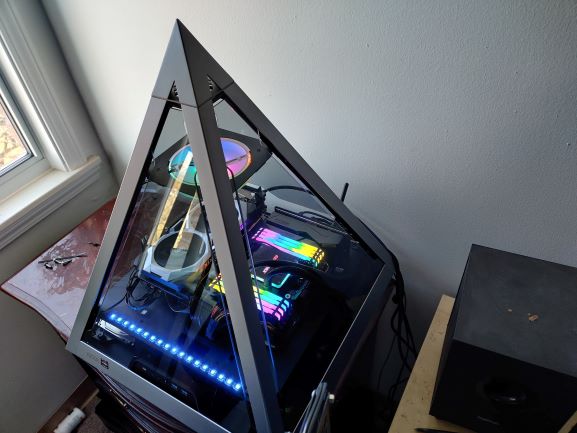
If you’re thinking of making a server or a database for your website and applications, you’re surely going to need a bootable computer system without requiring any peripherals like keyboards, mice, and monitors. For such a server, there is no need for a peripheral because there isn’t going to be any data entry.
You might be wondering, how do I boot a computer without a keyboard, mouse, or monitor? Well, that’s precisely what I’m here to tell you.
In this article, I’m going to talk about what a headless computer system is, boot a computer system without any peripheral devices, and the different uses of a headless computer. So, make sure you read this article attentively till the very end.

Table of Contents
What is a Headless Computer System?
A computer system configured to be booted without a monitor, keyboard, and mouse is known as a headless computer system. It is used mainly as a server.
You might have seen rooms filled with racks and computers in them in movies. These rooms were always referred to as server rooms. Well, all these computers are headless systems and used as servers of different kinds.
Every computer requires a mouse, keyboard, and monitor to be booted up initially. However, it can be manipulated and configured so that it can be powered up with only the press of a button and doesn’t require any peripheral devices anymore.
Uses of a Headless System
So, what kind of things can you do with a computer that boots without a keyboard, mouse, or monitor? There are many possibilities, and it honestly depends upon what kind of work you want from your headless system. Let’s take a look at some of the common uses of a headless computer system.
- Web Server – If you’re building a website, you’re going to need to install a live server of that website that manages all the coding, plugins, elements, and hosting of that website and its pages. For that reason, you can use a headless system as a web server.
- Data Server – If you’re running an open-source system that saves information and data about users and members, then to save that data and keep it protected from unauthorized access, you can use a headless computer system for the security of that data by transferring data to it.
- File Server – Dealing with a lot of imports and exports of files on your software application? Well, you’re going to need a server to make sure the file transfer is safe and protected from all external unauthorized access and is securely protected.
- Storage System – Another great use for a headless system is remote access; you can use that system for storage. It’s better than storing important data on hard drives because the chances of an unused hard drive corrupting are vastly greater than a storage device hooked up to a headless computer system in an active state.
How to Boot a Computer Without a Keyboard, Mouse, or Monitor
As I said before, if you want to make your computer headless, i.e., make sure that it can boot without a keyboard, mouse, or monitor, you’re going to have to boot it first with all of these things.
But after a proper configuration, you’ll be able to use the computer system without needing peripheral devices. So, here are the two ways you can boot your system without a keyboard, mouse, or monitor.
Method 1: Editing Windows Registry
This method of converting your normal PC to a headless system only works with Windows operating system. You’re going to have to boot up the system once before you unplug the monitor and peripherals once and for all. Here are the steps you’re going to have to take.
Step 1 – Go to Windows Registry
The first thing you’re going to want to do is to go to the Windows registry. There are several ways to do so. You can open Run by pressing Window key + R and type “Regedit,” or you can go to the Windows search bar and type “regedit.exe” to open the Windows Registry for taking further actions.
Step 2 – Head to Winlogon
Now, the locating part begins. Let’s take a look at the folders you’re going to move through before you find Winlogon.
- Click on HKEY_LOCAL_MACHINE.
- From there, you’re going to open SOFTWARE.
- Then go to Microsoft and Windows NT.
- In here, you’ll see CurrentVersion; click on it.
- Finally, you’ll see the option of Winlogon; go ahead and press it.
Step 3 – Type Login Credentials
Here, you’re going to want to type the login username and password credentials according to your requirement. Firstly, click on DefaultUserName and edit it as you wish, then go to DefaultPassword, fill in the password box, and press OK to save the settings effectively, so you don’t have to do the typing again.
Step 4 – Tweak AutoAdminLogon
The main game-changing step will be performed in this step. You’re going to find AutoAdminLogon in the Windows Registry and turn its value from 0 to 1, which means that the computer will not require a password and username when it is booted, allowing the computer to open without any need for on-time authorization access.
Step 5 – Unplug the devices and use the system
You’re all set. You can take all the wires and cables out, unplug the monitor, keyboard, and mouse to reveal what is now a headless PC. It can be used as a server with the help of a remote application or device as you want it to be used. You won’t need to use the peripherals to boot it anymore. All you need is to press the power button, and voila!
Method 2: Configuring Linux Server
In case you’re on a Linux-based system or using Mac OS, you can download and install Linux on your system and configure it to allow the system to boot up without a keyboard, mouse, or monitor. Let’s take a look at the configuration to know how you can make your system go headless.
Step 1 – Enabling SSH or Telnet
With the Secure Shell or Telnet service that Linux provides to its users, you can effectively turn your computer headless and use it as a server without a problem. You’re going to need to activate SSH or Telnet to make sure bidirectional communication is enabled, and the remote access transmission works effectively.
Step 2 – Choosing Secure Passwords
Then you’re going to make sure that the default passwords are removed and are replaced by actual secure and protected passwords that cannot be decrypted or hacked by unauthorized users in such a way that they gain access to the headless Linux server. Make sure the passwords being used are easy to remember and hard to crack.
Step 3 – Start the SSH or Telnet
On the second computer, which is the primary computer and will be used as the host for remote access, you’re going to want to start SSH or telnet and make a secure connection. This is where the bidirectional textual communication will come into play, and the connection will be established.
Step 4 – Connect to the Headless Server
You’re all done. Now, you can connect to the headless server any time you want and get remote access to it from your primary computing device even while being far away from the server. Linux servers are quite well-encrypted and protected, so you don’t need to worry about the system being bypassed by unauthorized users either.
How to Boot a Computer Using Remote Access Applications?
Whether you’re using a Windows, Mac OS system, or a Linux-based computer system, the ideal way of booting your computer without the help of a monitor, keyboard, and mouse is by using a remote desktop application.
There are many different applications like Team Viewer, Mikogo, which you can use to get remote access to your headless systems. Let’s take a look at how these applications, particularly Team viewer, allows you to boot a computer without a monitor and peripheral devices effectively.
- Download the application in your server device and the remote device like a mobile phone or preferably a computer system.
- Allow giving access to the primary device so you can access the headless system once it has been disconnected from a monitor and the peripheral devices connected to it.
- After configuration, whenever you start the system with the power button, access can be gained to the headless system from the primary device using the remote access application.
- You can perform all kinds of server-based actions on the headless system according to your website or application requirements.
Conclusion
Knowing how to boot up a computer system without a keyboard, mouse, or monitor is very important if you’re thinking of establishing a headless server and run a database or a website.
I hope that this guide helped you learn quite a lot about doing so on all platforms. Make sure you implement your learnings practically, so your servers perform well. I hope that you have a great time headless booting up your system without requiring any peripheral devices.
